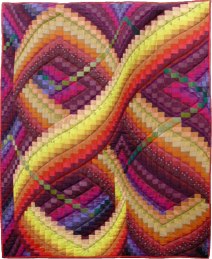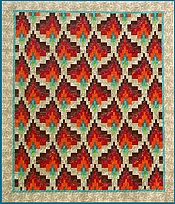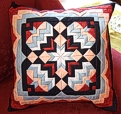
We were so lucky as to get to see the exhibition of 1000 Bodice Inserts at Hardanger Folkemuseum at Utne last October.
A bodice insert is a separate piece of fabric covering the front opening of the bodice on the folk costume from Hardanger and some other areas.
Folk costumes in Hardanger, and also in other areas in Norway, were influenced by continental fashions. The renaissance fashion trend with waist and skirt in differing colours, and often heavily decorated bodice inserts, kept its stronghold in this area till the costume was embraced as the National Costume of Norway in the late 1800s. It was a living tradition, so no need to go back to study old garments in order to reconstruct the costume, as has been done later in other areas to create local folk costumes. (We now have lots of different folk costumes in all areas of the country.)

Luckily a lot of old and new bodice inserts from Hardanger have been donated to the museum over the years. There are also collections in neighbouring districts, and some of these were also on display, – a total of more than 1000 bodice inserts, and not two alike.

People have used a variety of techniques to decorate the inserts, and cross stitch embroidery seems to have been a popular method. All the inserts on the wall to the left in the photo above, are decorated in this way.
The amount of decoration vary from very simple to elaborate. People used the same style of clothing both for every day use and for Sunday best and other festivities, and they often had several bodice inserts to fit the occasion.

Unadorned bodice inserts were used when attending funerals, and grieving.
The size of the inserts vary a lot. This may be due to variations of the waist front opening, and also the fact that people come in different sizes. A couple of hundred years ago, people were generally smaller than we are now.
Even though hardly two bodice inserts are alike, there are some common standards. They all have a ribbon hem on top. Most have a defined motif of various geometric shapes sewn on red or white fabric. Between the ribbon and motif there is often a border made of metal lace or ribbon, beads, or embroidery. The decorated parts are mounted on a piece of fabric, which is mostly made of home woven wool or linen. This background fabric is not visible when the bodice insert is in use.
It is almost as interesting, – or perhaps more so, – to observe all the different background fabrics that have been used.
The most common geometric motif is by far the eight pointed star, also called an eight leafed rose in these parts. The variations are many, there may be one big star, or a few or several smaller ones set in a grid, most often on point. The grid itself may be narrow, or wider with geometric decor elements of its own.
In quilting terms we might call the decor on point blocks with narrow or wide sashings.
Quite a few inserts have beads on them.
At a time when most household items were home made, purchased objects would be regarded as finer and having a higher status. Beads have been produced and sold for many years, and bodice inserts decorated with beads were regarded as especially fine and for best use. The inserts can be dated by looking at the colour of the beads. White, green, mustard, and black beads were first available. Blue beads and straw beads came later. Also the older beads are bigger and of more irregular shape than newer ones.
The motifs are again mostly geometric borders and eight pointed stars, but also heart shaped decor has been popular.

On one insert with very small beads, they found that the maker had used horse hair to thread the beads. The horse hair is so stiff that you would not need a needle, which would perhaps have been to thick for the small pearl openings.
Pearls have been combined with both embroidery, metal lace and ribbons, and also applique as in some of the photos below..
There is a story about three vicar’s daughters from Ulvik who used to do very fine applique, mostly eight pointed stars. When their father died, they supported themselves by making fine bodice inserts for sale. At the time, paper was used inside the top hem to make it stiffer, and much later one of their father’s sermons was found inside one of these inserts.
Not all bodice inserts were made from woollen fabric. Some used fine imported silks, silk velvet and calamanco. A few of these were displayed behind glass.
The pattern darning technique has also been used to decorate bodice inserts.
Pattern darning is a very old embroidery technique, – even older than cross stitch, – and this technique has been used quite a lot. Pattern darning is often used alongside other techniques, where the pattern darning will compose the grid, or framework, for the motif, while other techniques such as cross stitch or satin stitch, are used to fill in the pattern repetitions.
A very common motif on pattern darning inserts is the “eldjarnrose”, which looks like a modern day hashtag set on point. It is most often worked in black, while the surrounding grid has been made in red yarn.
This last group of photos show some inserts made in a variety of techniques, and some of them with unusual motifs. There are a few examples where the cross stitch embroidery patterns are made to look like bead embroidery or threaded bead grids. There is also one with a great variety of stitches, including the only example of chain stitch that I noticed.
Lastly, here is an insert mounted on a piece of fabric cut from a beautiful woven coverlet in the “krokbragd” pattern:

The exhibition was scheduled to be taken down last January, but due to its popularity, it has been extended till 1st November 2019. If you get the chance to visit, grab it with both hands.
It is well worth a visit.
🙂
Eldrid
Filed under: embroidery, memories, sewing, textiles, tradition | Tagged: applique, beading, beads, block pattern, bodice, bodice insert, chain stitch, costume, crafts, cross stitch, darning stitch, embroidery, embroidery stitches, exhibition, fashion, flowers, folk costumes, heart, inspiration, memories, museum, national costume, on point block, on point grid, sashing, skirt, thread, tradition, travelling, woven coverlet | Leave a comment »




















 KameleonquiltGallery of quiltsPatterns
KameleonquiltGallery of quiltsPatterns
































































































































































































